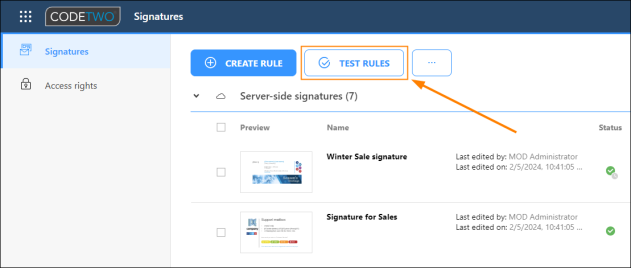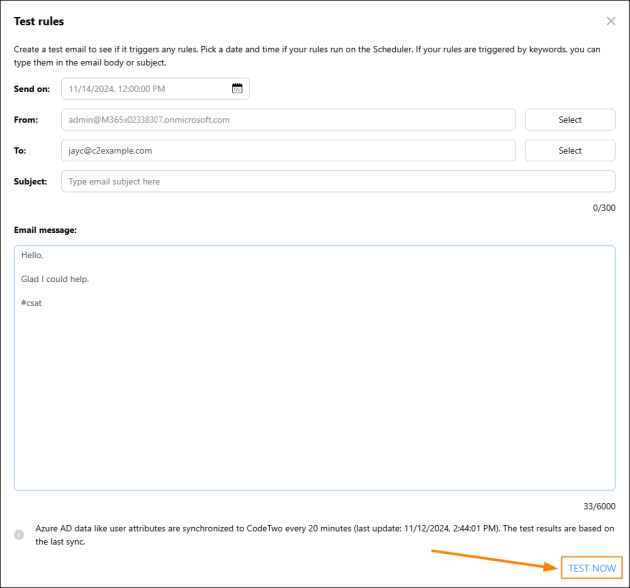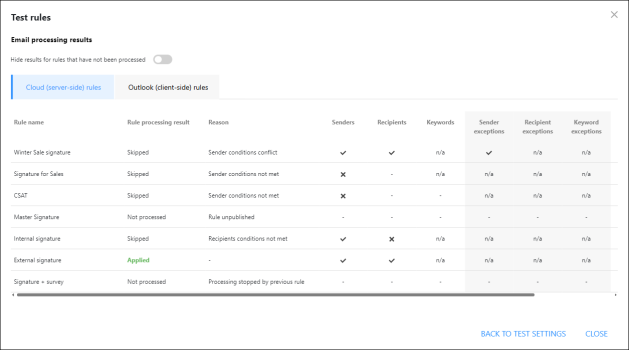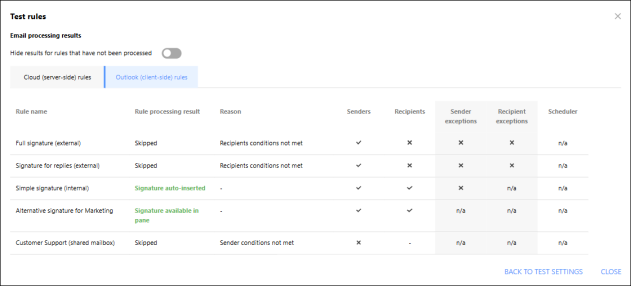Test signature rules
The built-in signature rules tester allows you to create a test email to see if it triggers any signature rules you have.
You can use it, for example:
- to check if the correct signature will be added to a specific email (useful especially when you have a lot of rules configured),
- for troubleshooting purposes (to find out why your signature was not added, consult your rule setup with CodeTwo support, etc.).
How to test rules
Sign in to the Signatures app and click TEST RULES to open the signature rules tester.

Fig. 1. Opening the signature rules tester.
Create a test email (Fig. 2.) by providing the following information:
- Send on – select a date and time when the email is sent. This property applies only to rules that are activated by the Scheduler. If you don’t select anything, the sending date will be the same as your current time.
- From – add the sender’s email address. By default, the field contains the email address of the signed-in user. To change it, click Select and choose a different sender (user or shared mailbox) from your Microsoft 365 tenant. Only users included in the scope of licensed users will be shown. Note that you can specify only one sender, and only their primary email address can be used.
- To – type or select the recipient’s email address. If the recipient is internal (and included in the scope of licensed users), you can select their email address by clicking Select > User (inside organization) or Group (inside organization). If the recipient is external, type the email address manually. You can select only one recipient.
- Subject / Email message – complete these fields only if your rules are triggered/suppressed by keywords or phrases, and you want to test these phrases in the email body or subject. Learn more about this feature
Click TEST NOW (Fig. 2.) to run the rule testing.

Fig. 2. Creating a test email in the signature rules tester.
Important
If your rules are based on Azure AD data (e.g. user attributes) synced to CodeTwo, see the information shown below the email message field (as shown in Fig. 2.) to check when the last sync took place. The test results are based on the last sync. Learn more about the Azure AD filter feature
Check results
The test results are displayed on two tabs: Cloud (server-side) rules and Outlook (client-side) rules, as shown in Fig. 3. If you only use one type of signature rules, only one tab will show the test results. Use these links to learn how to understand the results:
Test results for cloud (server-side) rules
The signature rules tester checks which rules apply to your test email based on the CodeTwo rule settings (e.g. the order of rules, conditions and exceptions, or rule processing settings) in your organization. See Fig. 3. for sample test results.
Important
The rules tester only checks your rule settings. This means that it does not analyze the scope of users whose emails are routed through CodeTwo (via Exchange Online connectors).
The Rule processing results column shows which rules were applied (shown in green) and which weren't. To find out why a specific rule wasn't applied, see the information in the Reason column.
By default, the results pane shows all your rules. To hide rules that have not been processed, use the toggle above the tabs.

Fig. 3. Email processing results for cloud (server-side) signature rules.
The remaining columns (Senders, Recipients, Keywords and so on) show additional information on how specific conditions were processed for each rule:
 – condition met or sender/recipient/keyword found on the exceptions list;
– condition met or sender/recipient/keyword found on the exceptions list; – condition not met or sender/recipient/keyword not found on the exceptions list;
– condition not met or sender/recipient/keyword not found on the exceptions list;- - – not processed;
- n/a – not applicable (not set).
See the following examples for more information on how to interpret test results for cloud (server-side) signatures:
Example 1
Q: The test email shown in Fig. 2. includes the following keyword in the email message field: #csat. However, according to the results shown in Fig. 3., the associated rule (CSAT) was skipped. Why?
A: The reason for skipping the rule is: Sender conditions not met. If you look at the rule settings (Fig. 4.), you'll notice that it only applies to members of the Sales and Marketing group. This means that the sender specified in the test email doesn't belong to that group.

Fig. 4. This rule applies to members of a specific group only.
Example 2
Q: All conditions set for rule Winter Sale signature are met, as indicated by the ![]() icons in the Senders, Recipients and Senders Exceptions columns (see Fig. 3.). However, the rule was skipped. Why?
icons in the Senders, Recipients and Senders Exceptions columns (see Fig. 3.). However, the rule was skipped. Why?
A: Here, the reason states: Sender conditions conflict. The ![]() icon in the Senders Exceptions column informs you that the sender specified in the test email is included in the exceptions list for this rule. You can double-check that by looking at the rule's settings (Fig. 5.).
icon in the Senders Exceptions column informs you that the sender specified in the test email is included in the exceptions list for this rule. You can double-check that by looking at the rule's settings (Fig. 5.).

Fig. 5. This rule won't apply to senders added to the exceptions list.
Test results for Outlook (client-side) rules
The signature rules tester checks which signatures defined in Outlook (client-side) rules will be available in Outlook for the end user (sender) specified in the test email. See Fig. 6. for example test results.
The Rule processing results column shows which rules were applied (the related signatures were either automatically added to an email in Outlook or made available in the add-in pane; both situations are shown in green) and which weren't. Since mobile devices do not support the pane, the Signature available in pane status does not apply to Outlook for iOS and Android. To find out why a specific rule wasn't applied, see the information provided in the Reason column.
By default, the results pane shows all your rules. To hide rules that have not been processed, use the toggle above the tabs.

Fig. 6. Email processing results for Outlook (client-side) signature rules.
The remaining columns (Senders, Recipients, Sender exceptions and so on) show additional information on how specific conditions were processed for each rule:
 – condition met or sender/recipient found on the exceptions list;
– condition met or sender/recipient found on the exceptions list; – condition not met or sender/recipient not found on the exceptions list;
– condition not met or sender/recipient not found on the exceptions list;- - – not processed;
- n/a – not applicable (not set).
Important
The test email is treated as a new message. If you set different default signatures for replies/forwards (as explained here), the results for Outlook (client-side) signatures will not reflect that.
The test results are based on a single recipient only. See this article to learn how CodeTwo behaves when you send an email to multiple recipients to whom different Outlook signature rules apply.
In this article